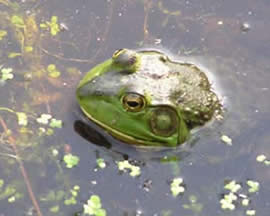

NATURE NOTES

American Bullfrog, photo by Hugh Griffith
The Menu and the Damage Done
We have a long and complicated history of eating other animals. When we discover it is possible to eat a rare thing, and it turns out not to be revolting, that rare thing becomes, to its detriment, a delicacy. Are delicacies good? Ecologically thinking, probably not.
The most drastic ecological result of eating a delicacy is eating it into oblivion. The western pond turtle once lived in the lakes and ponds of southern BC. It was delicious, thus gone by the mid-20th century. It was an omnivore and scavenger. Its disappearance certainly altered the ecology of our wetlands.
Our native oyster, the Olympia oyster, also was very tasty, thus so depleted by the 1930s that another species was introduced to take its place. The Pacific oyster, native to Japan, was a fast-growing substitute, but brought with it a slew of other shellfish. Among the tiny larval Pacific oysters lurked the larvae of other molluscs, clam and snail. A stroll along any Lower Mainland mudflat will reveal plenty of sea shells, but the most common are Japanese little neck clams and mudflat snails, often in overwhelming numbers.
One of the most devastating introductions of strange food, uh, delicacies, to local ecosystems was the result of ill-planned entrepreneurialism. We have bullfrogs in southern BC, which grow to the size of baseball mitts, from eastern Canada. Why? Yummy frogs’ legs. Supposedly they taste like chicken. How long does it take to grow a bullfrog to chicken-taste size? Too long, so the froglets were tossed. They grew and thrived by eating everything else. They were caught, transferred elsewhere and dumped again and again, as humans carried out the manifold weird things we do with wildlife. Now they are everywhere.
I was watching a garter snake in the pond at the Nature Park, a creature that normally wouldn’t be under threat of predation save the presence of a poised heron. Suddenly a bullfrog exploded from the mud and grabbed it at mid-body. There was a terrific battle that ended when the snake wrapped its tail around a stick and peeled itself from the bullfrog’s grasp. The bullfrog settled back into the muck, ready for the next victim. The snake sped away with an unmistakable, "What on earth was THAT?" expression on its face.
Hugh Griffith is a BC zoologist and science writer.
Please cite these pages as:
Author, date, page title. In: Klinkenberg, Brian. (Editor) 2023. E-Fauna BC: Electronic Atlas of the Fauna of British Columbia [www.efauna.bc.ca]. Department of Geography, University of British Columbia, Vancouver. [Date Accessed]
© Copyright 2023 E-Fauna BC.